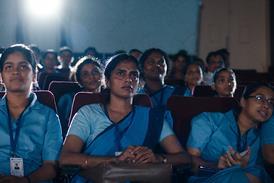For close to a decade the underlying question at ShoWest was when would digital cinema become a factor in film exhibition. And for years industry pundits responded that it was five to ten years in the future.
“We could see it coming,” Jerry Foreman of Pacific Theaters, a key player in the creation of ShoWest, said. “And then it just happened.”
There are an estimated 7,900 digital screens in North America (3,800 that can show 3D digital) that account for about 22% of all screens. With the recent success of Avatar and Alice In Wonderland, there’s no question that the major film distributors and every theatre operator from Anchorage, Alaska, to Ocala, Florida, would like to convert their 35mm venues into digital projection facilities.
All the manufacturers of digital projection equipment have attended the Las Vegas convention, and most have made an aggressive, high profile push to sell their wares.
However while established circuits in metropolitan areas have multi-year plans to make the transition, with the studios assisting via a virtual print fee to defray costs, smaller operators based in less dense areas of America are feeling the pressure of a ticking clock. Some paint a picture of a landscape that evokes The Last Picture Showin which local movie palaces once stood majestic.
“We want it yesterday,” one independent Illinois-based exhibitor said. “We’re shopping around for the system that’s going to provide the absolute best picture. It’s an investment of hundreds of thousands of dollars and frankly, in this economy, we have no idea what bank or investor will provide us with a reasonable loan.”
“There’s no question that some film theatres aren’t going to make it,” the National Association Of Theater Owner’s president John Fithian said. “It’s a real concern and we’ve established initiatives that specifically target smaller operations. The Cinema Buying Group has been set up to address the real problems they face in terms of financing. They’re meeting on the last day to debate the roll-out. We expect 260 members and it will be the biggest meeting during the conference.”
Fithian estimated that in five to eight years distributors will stop making 35mm prints. Pacific Theaters’ Foreman, citing such factors as production logistics, maintenance and inevitable modifications, believed that time is more likely at least ten years away. Regardless, it’s close enough for those affected to feel the pressure of conversion or death.
“The survival of these theatres is vital to a lot of small towns,” Fithian said. “If they can make it work I believe they have a better chance of survival because the economics of getting new films on a national break is much more feasible.”
There are increasing instances of town governments assisting the local cinema or buying it outright to preserve its place in a community. And similar initiatives are occurring internationally.
“Of course the government is much more involved in Great Britain,” Film Distributors’ Association president Lord David Puttnam said. “The UK Film Council provided the initial funding for the development of digital cinema. The government will provide some funds because it sees the possibility of cinemas as a community centre. It provides a social function and digital opens up the possibility of a much broader range of films that can be shown, as well as multiple uses that involve non-film activities.”
Alternative content proved to be another key talking point at Showest. The major supplier National Cinemedia is owned by Regal Cinemas, AMC and Cinemark, the three largest exhibition circuits in the US. It has largely been fuelled by performances of live opera and simulcasts of sporting events that have often grossed $1.5m from single screenings in 700 theatres nationwide. However, there have been initial forays into such areas as interactive video games and new media aligned to film.
“I see it as filling in spaces,” Fithian said. “The main business is always going to be film and as interested as we are in the movie events, we are equally concerned about independent film and movies for adults. We’ve studied this area and you can see a steady, alarming box office decline in the past decade. There has to be a diversity in the movies being shown at the multiplex; its growth depends on it.”

























No comments yet